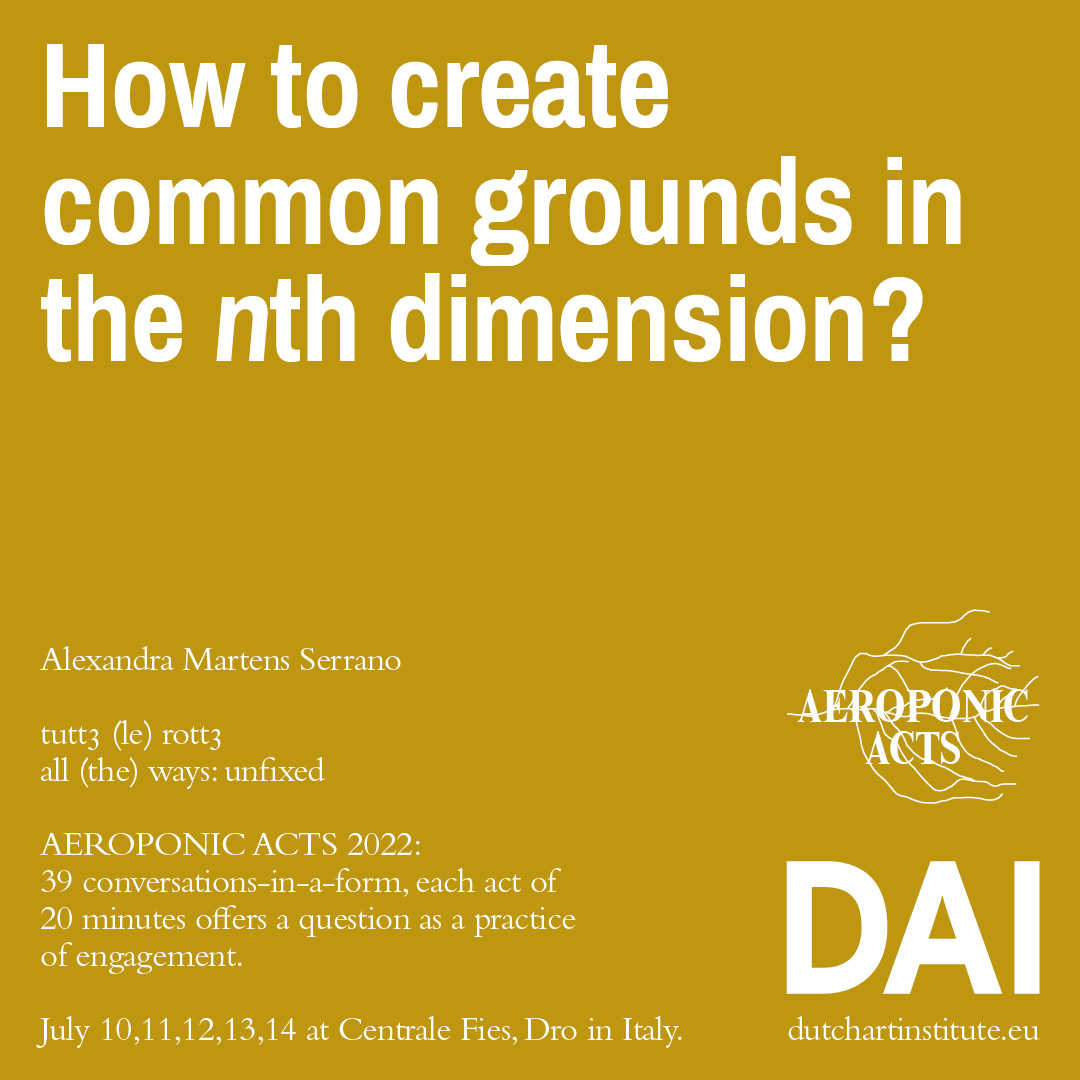Alexandra Martens Serrano: Navigational Strategies for a Horizonless Datum
‘Aeroponic’ – root systems nourished by air – Acts is the name given to the nomadic Dutch Art Institute’s final Kitchen presentations. Each participant addresses one question, as a practice of engagement.
Here you will find the documentation of Alexandra Martens Serrano's presentation as filmed by Baha Görkem Yalım. The written report is by Hubert Gromny and it includes a summary of the comments by esteemed guest respondents.
Navigational Strategies for a Horizonless Datum
Alexandra's question: How to create common grounds in the nth dimension?
Alexandra's introduction: This is not simply about seeing; by definition, navigation organizes timescales and orders of magnitude that cannot be visualized simultaneously. The evolution and eventual dissolution of a horizon line invites (un) orientation and the creation of shifting heterotopic grounds as a technology of intimacy and transportation through expanding dimensions.
Hubert's report: Audience enters the space with three large paintings placed horizontally on the floor. Three performers are standing on each of them. Miel Ferraez is lying on painted textile cut out in shape of arrows pointing outwards. Dandelion Eghosa is sitting on the painting resembling depictions of outer space. Alexandra Martens Serrano is walking in a circle on the fabric with colorful organic patterns. These depictions are anamorphic, situated between the figurative and abstract representation. Positions which allow to see the paintings differently are marked on the floor. Droning sound emanates from the speakers coordinating movements of the performers. Each of them in a different is balancing the body while standing, sitting, walking or lying on the floor. The performance unfolds itself in three chapters, when attention of the audience is directed to each singular performer, who at the time recites the text. The text speaks on ways of spatial comprehension as a practice exemplified by poetic and performative juxtapositions of words, movement of bodies and their relationship to the soundscape. The piece finishes with a closing statement “this text is a textile” announced by all performers at once.
Ana Teixeira Pinto voked a history of invention of n-dimensional space–especially a 19th century discourse reflecting on a higher dimension beyond three-dimensional space. During that time a question whether this space has physical properties or is a purely mathematical construct was a subject of heated debates. Ana contextualized these debates with the question of gender and pointed out its uncanny aspect. Visualizations of n-dimensional space tended to be based on the idea of an inversion of three-dimensional space and as such the fourth dimension is a space turned inside out. In order to exemplify this uncanny aspect Ana referred to allegations that Lewis Carol was a famous serial killer Jack the Ripper due to his interest in n-dimensional space, which potentially inform the fantasies of violence by imagining bodies to be turned inside out. Ana pointed out also the importance of remembering that history optics developed parallel to the imperial gaze through inventing the concept of a territory observed from a bird-like point of view. The closing comment of the response touched upon alternative practices to occidental navigation and opening spaces for possibilities which are not yet completely defined.
Phanuel Antwi invoked Sarah Ahmed’s book “Queer Phenomenology” where the author discusses the notion of orientation and orienting oneself towards the other and the environment. Phanuel re-interpreted the question of navigation as the one of drawing lines, which allow to see how a person in front of another is making a self available and reachable. In that sense navigation can be re-formulated as a mode of reinventing self. What is offered through thinking that way is the attention to the questions of how to be guided and how to navigate through the unknown. Within the performance this way of seeing navigation was made visible. Especially in the moments when performers were almost unable to stay on the ground and in the way the relationship to the audience was created. The piece was navigating itself outside of the commitment to the large gestures and was seeking for intimacy instead.
Momtaza Mehri reflected on the distribution of attention during the performance as scattered and deterritorialized, which was informed by the topic of navigation. Momtaza pointed to the active relationship between the performers to the floor, and an activation of an upright position by constant balancing, falling, standing, lying and other ways of engagement with the ground. The audience was incorporated to the piece and placed in relation to the spoken text and performative gestures. Momtaza drew attention to the poetic element of the text, and singled out the line about “world we can see at once” in order to reflect on the boundaries of the self within Édouard Glissant’s theories on deterritorialization. She observed the active bond between text and textiles and suggested that similar amplification could be relevant for the sonic part of the performance. Usage of delay effects and sound mirroring could emphasize further the tense and contradictory relationship to the space presented by the piece.
Alexandra Martens Serrano's "Navigational Strategies for a Horizonless Datum" was presented before live audience at the Centrale Fies, Dro, Italy on July 10th.
Find the overview of all 24 AEROPONIC ACTS 2022 here: tuttə (le) rottə - all (the) ways: unfixed


